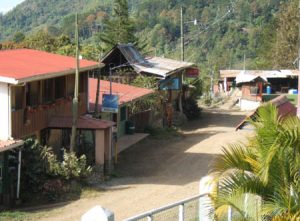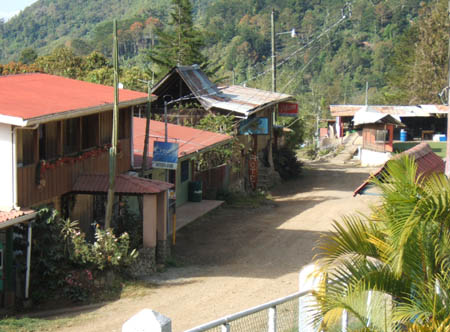by Jed Minor (Editor-in-Chief)
Email: jed[at]ufvcascade.ca
San Gerardo is the mos t beautiful place in the world. Sorry B.C., I love you too, but San Gerardo, Costa Rica has something you don’t – eternal spring.
t beautiful place in the world. Sorry B.C., I love you too, but San Gerardo, Costa Rica has something you don’t – eternal spring.
San Gerardo is located high in the mountains of Costa Rica, right next to Mt. Chirripo, the second highest mountain in Central America, and the temperature usually hovers around 20-30 Celsius year round. It gets a bit chilly during the night, but that just makes the mountain village seem that much fresher in the morning.
Also, hiking in San Gerardo means constantly smelling the fresh scents of herbs and flowers; if you’re into that sort of thing…
In January 2009 I had the opportunity to volunteer with Proyecto San Gerardo (PSG), a small non-profit run by Jenny Moss and her family, who are originally from Vancouver. I taught computer skills for three months while staying with a local family, and it was one of the best experiences of my life. Recently I caught up with Jenny Moss to find out a little bit more about PSG and pass that information on to you, dear reader.
What is Proyecto San Gerardo (PSG)?
Proyecto San Gerardo began in 2007 as a community-based non-profit in San Gerardo de Rivas, Costa Rica. It exists to provide training and support to enable local community members to acquire better jobs – especially in the local tourist industry.
San Gerardo is located in south-central Costa Rica, in the Talamanca Mountain Range and at the foot of Mt Chirripó – the second highest peak in Central America and an astonishing climb. Hikers come from all over the world to see the famous Crestones – rock formations – the lagoons, and the wildlife that abounds in Chirripó National Park.
As a result, there are always opportunities to develop tourist-related employment, and Proyecto San Gerardo provides courses such as English conversation, computer skills and first-aid training, as well as a local website: www.sangerardocostarica.com, a scholarship fund, small business planning, and support, especially to women and youth.
What were you doing before you started PSG?
Beforehand I lived in Vancouver, BC and worked for [the] Canadian Red Cross as their Community Liaison Coordinator working with more than 20 immigrant populations to provide training as well as a conduit for their expectations from Red Cross. It was from this experience where I worked closely with more than 100 volunteers that I learned the power or volunteerism, and so Proyecto San Gerardo relies heavily on the wonderful volunteers who come here to teach each year.
Where did the inspiration for PSG come from?
In 2006 we were approached by a young woman who wanted to learn English. When I asked her why she wanted to learn English she said it was so she could go to the USA and find work. Knowing she had no high school education or resources to enable her trip, I was not surprised when she admitted she would enter the country undocumented and work ‘under the table.’ Knowing what often happens to vulnerable young women trying to travel through Central America and Mexico for the USA, we agreed to offer English classes, but in order to help people secure work here in Costa Rica.
What were the early steps in getting the organization going?
Early on my daughter Liz, who is a founding member of Proyecto San Gerardo, trained as an ESL teacher and first-aid instructor, as well as built up the teaching resources we would need. At the same time, we approached the local Asociacion de Desarollo (literally – “the Town Council”) to discuss the idea and gain their support and advice. They have provided free of charge all our teaching spaces and advocated on our behalf. Equally, I worked with the local Camara de Turismo to develop the website and local brochures, and their members pay a small fee monthly to maintain the site.
Our computers came from a generous donation from Vancity in Vancouver, who have provided, to date, 14 laptops to Proyecto San Gerardo. This provided the incentive to start the computer classes.
Our first volunteers came from the same ESL training classes as me and Liz until we could begin broadcasting our volunteer recruitment world wide through organizations such as idealist.org
What are the biggest obstacles in the way of the development of PSG?
Of course funding, like everyone else! We rely on donations to augment the small income from our website fee, membership fee, and local events where we sell our recipe book and other items. Every year we provide scholarships to the value of $1,000, so donations from supporters or fundraising projects are always welcome.
It is challenging to find the right kind of volunteers. We need independent people with initiative who enjoy living away from city amenities and flourish in the natural environment of San Gerardo.
Our computer teachers need to speak Spanish and our ESL teachers need to be certified at TEFL level or above. This is in order to provide the very best learning experiences and also to be assured that the volunteer teachers will have lots of resources and experience in order to be successful in this community where education to high school level is a relatively recent phenomenon. Not many adults here went to school beyond Grade 7 and don’t always have fond memories of school!
How many people are helped by PSG at the moment?
At the moment we currently have over 100 students on our books and five organizations.
Where do you see PSG going in the future?
In the future we really hope to work further in helping community members set up small businesses. Not only do people need access to small funds as a capital investment but they need assistance in planning, niche marketing, and accounting. We hope to bring in a variety of courses to assist as well as work 1:1 with individual projects.
Secondly, our goal is to set up a youth club, especially for young girls. There is little for girls to do in San Gerardo as the culture is still difficult for young women to act independently in. Too many young girls get pregnant and then have to wave goodbye to education or a better job possibility. We hope to start a club for 9 – 14 year olds to enable them to draw strength from each other, enjoy the natural environment, and learn how women can become leaders in the community.
How has PSG affected the local community in San Gerardo?
Well it would be arrogant to claim too much, but we do believe that individuals have had their lives changed by access to the courses and the scholarship fund, and visitors have been assisted through the website.
One of our students, Karol (aged 24), began studying English with us in September 2009. She completed her high school education by studying at home and this year won the PSG scholarship to attend university and study to be an English teacher. We are all in awe of Karol’s determination and success.
In addition, the community is benefitting through access to computers and the internet via Proyecto San Gerardo. We provide two free days a week for internet access and computer skills practice – a popular concept thought up by one of our great volunteer computer teachers.
I would also say that the coming together of two cultures in San Gerardo – the local ‘Ticos’ and the volunteers from all over the world – has done much to encourage cultural sharing and learning. ‘There is always more than one way to cook an egg’ – and Proyecto San Gerardo is helping people on both sides of the cultural divide learn that.
Is there any story or anecdote that sums up the mission of PSG?
When volunteers come to San Gerardo they stay with local families who are paid a modest sum for this hospitality. Many families have asked to join the list of host Proyecto San Gerardo families and one family recounted that without this additional income their daughter could not continue to study in San Isidro to be a tour guide. Our mission, to assist through all our activities the economic well-being of the community, is well illustrated by this simple but effective relationship with the community.
Anyone who would like more information on Proyecto San Gerardo – how to get involved as a volunteer or help with a fundraising scheme, should visit www.sangerardocostarica.com – Get Involved and email Jenny Moss at proyectosangerardocostarica@gmail.com. Generally volunteers who can commit to 6 weeks or more will have their homestay fees paid by Proyecto San Gerardo and can look forward to an unforgettable experience living in this rural Costa Rican community and getting to make new friends. If you think you have what it takes to volunteer please get in touch – Proyecto San Gerardo is looking forward to hearing from you!


